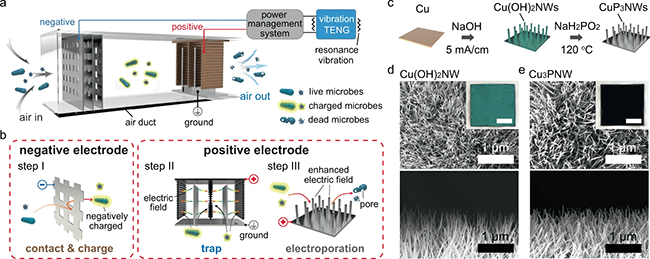Electroporation Air Disinfection System Powered by TENGs
| 26-07-2021 | By Liam Critchley
The modern-day world is very familiar with local epidemics' impact and how these localised outbreaks can turn into global pandemics. Several different airborne pathogens can cause severe epidemics and threaten public health, including pathogens that can cause a person to develop pneumonia, asthma, and influenza.
When a person becomes infected with a pathogen, that person can release micron-sized aerosols into the air, containing hazardous bacteria and or viruses. Releasing pathogens is often unavoidable, as the release into the air is facilitated by common daily motions, such as breathing, coughing, and sneezing. The parts of the aerosols with a small diameter—typically less than 1 micron—can travel for kilometres, so they can pose a threat to many people, especially in indoor and enclosed spaces.
Let us face it, pathogens are a part of everyday life and will continue to be for as long as humans are around. One of the most effective ways of preventing their transmission is by microbial inactivation in the air. However, the commonly used high-efficiency particulate air (HEPA) filters—do not inactivate microbes.
HEPA filters are excellent at filtering out pathogens. However, if a pressure drop occurs in these filters, it will prevent the microbes from being inactivated. Microbes that have not been inactivated cause an issue with the filters needing to be replaced more regularly. Not only can the operator be exposed to the pathogens, but the pathogens can also be released back into the air—negating the work already done by the filter. To counter this, scientists and engineers are looking at building air filtration systems that can inactivate microbes to prevent the spread of pathogens. One development to emerge recently is an electroporation air disinfection system.
Electroporation
Electroporation is a physical process that relies on a strong electric field to damage the outer structure of a pathogen—such as the membranes in bacteria or the capsids of viruses. These mechanisms have been realised efficiently with inorganic nanowires stacked vertically on a flat electrode, generating highly localised electric fields. This highly localised electric field can then be used to inactivate microbes. Electroporation-driven disinfection has already been confirmed for pathogen disinfection in water-based systems. However, until new research came out recently, there were no such developments for air disinfection systems because of the faster flow rates in air ventilation systems presenting challenges.
Triboelectric Nanogenerators (TENGs)
There are many different nanogenerators out there that generate electrical energy from different energy sources. These devices are energy harvesting devices and are often used to power small components and devices which cannot be charged by mains electricity. Triboelectric nanogenerators often referred to as TENGs, are among the most widely known nanogenerators. TENGs work by changing mechanical energy from their surroundings into electrical energy by harnessing the kinetic energy via contact electrification and electrostatic charge induction operation mechanisms.
In contact electrification mechanisms, the materials used in the TENGs become electrically charged from frictional forces with an external stimulus. Secondly, electrostatic charge induction then distributes these charges across the material. TENGs are lightweight, low-cost, and self-powering devices that have a high voltage output. They have gathered much interest for air disinfection systems, and TENGs have also been used in water-based disinfection systems. Questions surrounding air flow rate and if it was suitable for TENGs to power these disinfection systems led to a research team recently investigating.
Creating an Electroporation Air Disinfection System Powered by TENGs
Research teams from South Korea and China built a self-powered air disinfection system that uses an electroporation mechanism to inactivate microbes in the air. The system is powered by vibration-driven TENGs (V-TENGs). One of the challenges of introducing such disinfection methods into air filtration systems has been the need for an external power supply. However, the researchers have managed to overcome this thanks to the TENGs that convert the air's mechanical vibrations into electrical energy.
The electroporation disinfection mechanism was made possible by using copper nanowires, with the localised electric field damaging the outer structures of the pathogens, making them inactive. The electroporation disinfection mechanism assisted by the design of the system accelerated the charging and trapping of microbes.

Fig. 1: Working principle of the resonance-vibration-driven (RV)-disinfection system for air-transmitted microbes.
Thanks to its rational design, the air disinfection system promoted microbial transport and achieved greater than 99.99% microbial inactivation within 0.025s. Microbial transport was performed in fast, i.e., more challenging, airflow rates of 2 m/s and still showed this microbial disinfection performance. Moreover, there were only minimal pressure drops. The system not only overcomes the speed limitations of other nanowire-assisted electroporation mechanisms, but it also shows that there is the potential to use this type of disinfection method in commercial ventilation systems—something that had been debated and questioned before now.
As pathogens continue to cause epidemics worldwide, there could well be a need in the near future for a shift from a pure physical separation disinfection mechanism to a system that can separate pathogens and inactive them, so they pose no further risk. Whether these systems are commercially feasible over long-standing air filtration systems remains to be seen. A lot of it will ultimately depend on whether cost or the need to destroy pathogens is the driving factor for companies, institutions, and governments who may use such filters in their ventilation systems.
Reference:

